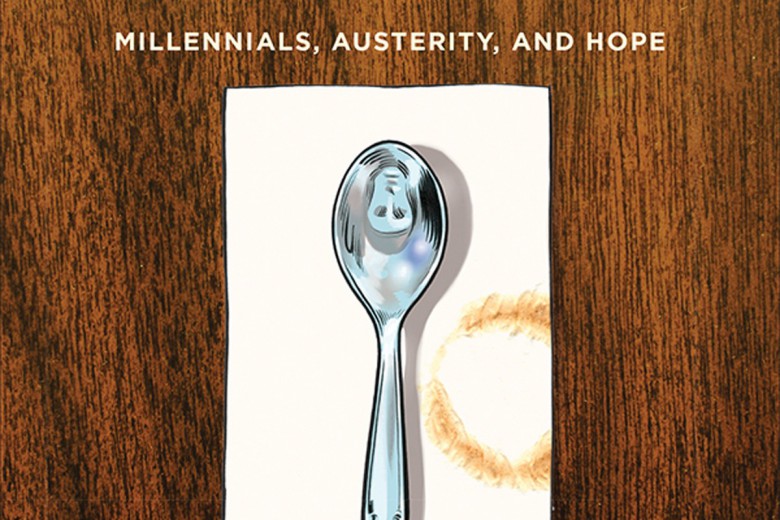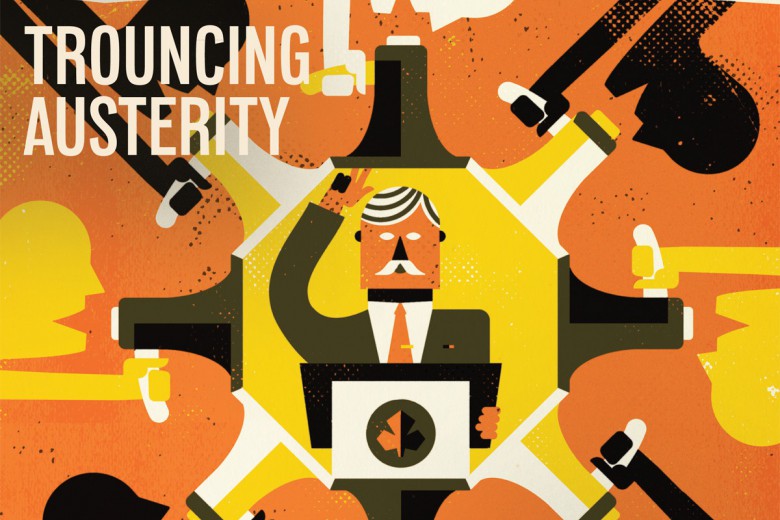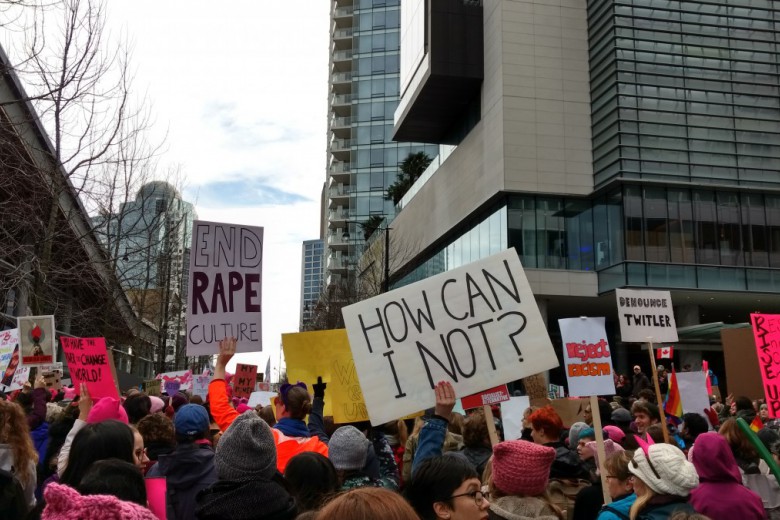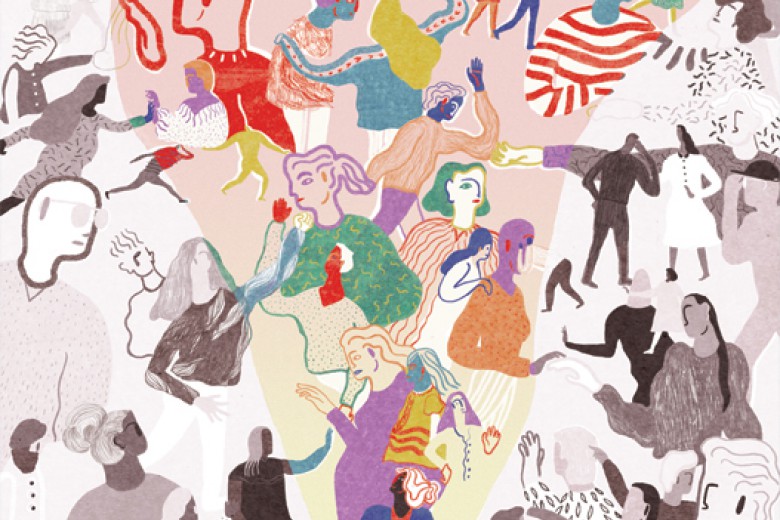In March 2017, the governing Saskatchewan Party, under Brad Wall’s conservative leadership, introduced a heavy-handed austerity budget. The priorities were clear: in order to rectify a $685-million deficit, the Sask. Party would gut education, health care, public transportation, social services, housing, pastures, and parks. Meanwhile, they would reduce corporate taxes to the lowest rate in the country, apparently to attract private capital – the so-called “Saskatchewan advantage.” About a month following the budget announcement, the government passed Bill 40, which secured their right to sell up to 49 per cent of Saskatchewan’s public assets without requiring public consultation. Bill 40 paved the way to eliminate the Saskatchewan Transportation Corporation (STC – the only public bus service in the province), which has stranded and endangered thousands of people without another safe or reliable means of travelling. It also leaves vulnerable other Crown corporations.
In response to the callous budget, people across the province have begun mobilizing in a broad coalition under the banner Stop the Cuts. The coalition has many goals, but it aims overall to pressure the Saskatchewan government to repeal its latest budget. So far, the government has responded to the mobilization by reversing its devastating $4.8-million cut to libraries and part of the cut to the funding of funerals for social assistance recipients.
Briarpatch invited into conversation four organizers of Saskatchewan’s anti-austerity movement.
Anti-Austerity Activists in SaskatchewanRob Caballero is a graphic designer and delegate with the Industrial Workers of the World (IWW) labour union in Saskatoon.
Emily Barber is a representative of Students Mobilizing Against Cuts, a grassroots collective organizing against the 2017 Saskatchewan budget. She is also a student at the University of Regina, and a community organizer.
April ChiefCalf is a soon-to-be unemployed faculty member with the Northern Teacher Education Program/Northern Professional Access College (NORTEP/NORPAC) in La Ronge, Northern Saskatchewan, where she has taught courses in educational foundations, women and gender studies, and Indigenous studies.
Chris Mulhall is a social justice and labour activist hailing from rural southwest Saskatchewan.
Stop the Cuts is a new anti-austerity movement building in Saskatchewan. What drew each of you to this movement?
RC: Aside from the uncompromising anti-austerity position that Stop the Cuts has taken from the beginning, it’s the methods of direct action and disruptive protest that Stop the Cuts was clearly willing to undertake that was so refreshing. Outside of Idle No More, most protests in Saskatoon seem like relatively small and symbolic events that group a like-minded set of people together but aren’t actually going to get in the way of, or otherwise inconvenience, the people responsible for creating problems.
I think that what I appreciate about Stop the Cuts is its willingness to shift the norms of acceptable protest in a direction that will favour the interests of workers and other marginalized people, and spawn more movements in the future where, say, it’s normal to blockade the cars of people actively funding our immiseration (as we did in our April 27 “Rally Against the Cuts” demonstration at the Saskatchewan Party’s annual fundraising dinner in Saskatoon).
EB: I was asked to become a founding member of Students Mobilizing Against Cuts (SMAC) by two fellow students on the eve of the 2017 budget release. Students are facing cuts to post-secondary institutions and government-funded financial assistance programs. The harm is not only financial; it also diminishes the quality of academic and student success programs. Personally, this budget endangers my well-being as a student, a queer individual, a woman, a non-profit worker, and a person living with mental illness. Between tuition hikes, increased cost of living, and precarious funding for the non-profit sector, I feel I’ll need to leave Saskatchewan to find less expensive graduate programs in cities I can afford.
AC: I was invited to join Stop the Cuts by someone who taught at the Northern Teacher Education Program (NORTEP). We had already been experiencing cuts in the North – the closure of the Buffalo Narrows Community Correctional Centre and NORTEP, and cuts to firefighters and social workers – and were fearful that more were coming. Sure enough, they did. We needed a unified movement of people who are not afraid to speak and act.
CM: Stop the Cuts has come at a moment when folks are having inclusive conversations about our communities and society. We seem to be bridging the divide between labour and other social justice movements. People seem to see that Stop the Cuts needs to be a movement against austerity, not just another short-lived campaign. That’s exciting to me.
In what ways is Saskatchewan’s austerity agenda distinct to Saskatchewan? How did we get here?
AC: The economic boom that began in 2007 saw record resource revenues in oil, gas, and potash that were neither invested nor saved. In recent years, the province spent billions on consultants, a new football stadium in Regina, a children’s hospital, a bypass, and a carbon capture and storage plant. These projects couldn’t be sustained by a boom-and-bust resource economy, and the Sask. Party had no plans in the event that revenues dropped. Meanwhile, long-promised projects, like an all-weather road to the northern Saskatchewan community of Wollaston Lake, had been abandoned.

Cuts to the North preceded the March 2017 budget. The funding cuts to firefighters threatened the North during the forest fires in 2015. Youth suicide and violence among youth is increasing in the North but there are not enough social work positions.
The $675-million deficit from 2015–2016 is now being used as an excuse to gut many social programs needed by vulnerable people in the province – those with disabilities and illnesses, the elderly, Northerners, and Indigenous people.
The deficit is being used as an excuse to gut social programs for vulnerable people in the province – those with disabilities and illnesses, the elderly, Northerners, and Indigenous people.
RC: When moving to Saskatchewan a few years ago from Alberta, I have to admit, I thought that Brad Wall had a different formula for austerity that worked well – from the point of view of sustaining the Sask. Party’s political power. Go slow, cut things very incrementally, as opposed to being a wrecking ball like Ralph Klein, who undertook huge assaults against the whole public sphere at once, and in doing so, built strong progressive and even radical movements in Alberta.
However, in many ways, Brad Wall’s “incremental” neoliberalism is the template of austerity. An austerity-minded government bides its time until some “crisis” (perceived or actual) can be seized to implement the whole austerity agenda. Advisers to austerity governments even recommend setting the stage for privatizing public services by getting rid of a few, less consequential ones at first, just to be able to have examples to point to and say “see, it’s not so bad.” But this softening of public opinion is really about creating the ground for more serious privatizations and divestment. When they get around to selling off transportation, major utilities, health and education, they hope we’ll be confused and arguing among ourselves, and any discontent aimed at them will remain a murmur. This is almost the script of what’s happened, except Stop the Cuts – and protests just prior to our formation – came together to amplify that discontent and cause problems for them.
Even now, we are sort of in a testing phase. If Brad Wall and Sask. Party ministers can get away with privatizations and divestment they are seeking now, then they are coming after health and education next. We have three more Sask. Party budgets to come and they are seeking to reduce the deficit to zero by the end of their term – there’s no question that it’s going to be on the backs of the poor and marginalized in our province.
What can we expect of Stop the Cuts in the years to come?
CM: Depending on the methods Stop the Cuts embraces, it might become another campaign instead of a coalition of allies. If that’s the case, it may not exist beyond this election cycle, especially if we can’t cement some tangible results. If, on the other hand, Stop the Cuts can position itself as an adaptable coalition that mobilizes against arising concerns, I can see it growing and evolving to be core to community activism for the foreseeable future.
RC: I think we’ll know that we’re effective not just when there’s a great many more people furious about the cuts and laying the blame at the feet of the Saskatchewan Party, but asking ever-broader and deeper questions. I think we’ve been successful at posing the question, “Why do any of these cuts need to happen?” and becoming a vehicle for people who agree that they don’t. But at the moment, I wonder if people are turning to traditional answers for why the cuts happened, that it’s just all about the “lack of compassion” of conservatives, or the Saskatchewan Party’s corruption. But we know that neoliberalism is a force that turns even well-intentioned governments away from policies which truly serve everyone.
I think we are nudging concepts like “austerity” and “neoliberalism” into the conversation, but at the moment, I think these are still interpreted to simply mean policy choices made by greedy people, as opposed to destructive tendencies within colonial capitalism itself.
The second thing that I think will convince people is if we, or some movement that arises, successfully initiates a conversation beyond just “stopping the cuts,” or restoring cut services – returning to an already-degraded status quo. I think we are nudging concepts like “austerity” and “neoliberalism” into the conversation, but at the moment, I think these are still interpreted to simply mean policy choices made by greedy people, as opposed to destructive tendencies within colonial capitalism itself.
I think if it becomes more obvious that colonial capitalism always has these serious flaws that work against the interests of most ordinary people, and you need a powerful people’s movement or movements to fight for ordinary people’s common interests, then yeah – I think Stop the Cuts, or whatever it might evolve into, will be relevant and strong.
As mobilization continues, there has been a lot of discussion about what tactics are “suitable” when it comes to resistance. What makes anti-austerity resistance effective?
EB: To someone who doesn’t realize that an effect of hollowing out the student loan programs means that some students will be unable to pay for food while they write exams, blocking cars from entering a cash-for-access dinner may seem extreme and unnecessary. But to those whose lives are directly harmed, the stakes are high: people are fighting to be seen and heard because their lives and well-being are endangered. When you make enough noise and flash enough lights, you’re bound to be noticed. And I’ll be damned if that’s not the point.
AC: There is no one way to fight austerity. Northerners have recently been very collegial and peaceful in dealing with government on various issues, but the truth is we are not being heard when we take this approach. Being more aggressive gets attention but also criticism.

RC: I think that this has been such an admirable feature of Stop the Cuts, as a loose movement – avowing confrontational protest, getting in the way, and refusing to be “protest-shamed.” Right-wing and conservative voices in the press try to demonize the movement through denunciation of us as “violent” (particularly for the aforementioned April 27 protest, which was confrontational, but wasn’t any worse than a picket-line scuffle). And the conservative media environment reliably ignores us or sensationalizes protester behaviour, which confuses a lot of people about the positive role of a confrontational movement. In spite of this, I think we’re discovering that our willingness to bird-dog public appearances of the Saskatchewan Party (for example) actually emboldens people and keeps them interested in what we are doing, as opposed to feeling resigned that the Sask. Party is just going to once again steamroll over everybody and get its way.
The Sask. Party’s approval ratings have plummeted from 62 per cent at the time of the 2016 election to a record low of 44 per cent in April 2017. But while the Sask. Party has taken a hit, the NDP in this province hasn’t posed a significant or inspiring challenge to the government’s agenda. Does this matter? What should we expect of electoral politics in resisting austerity?
EB: The Saskatchewan NDP has been in a rebuilding period since losing its 16-year run in government to the Saskatchewan Party in 2007. I don’t think it’s the place of Stop the Cuts – or any grassroots movement – to endorse political parties. Though the NDP appears to be the best available alternative to the Sask. Party, the grassroots left has to hold all political leaders accountable.
RC: I side pretty bluntly with the idea that people’s real political power is in self-organized, autonomous movements of our own creation. This is at odds with where many progressive people seem to think the power is – a social democratic party at the helm of government. At best, a sympathetic government might supplement our movements, but it will only ever have courage to act on the desires of working and marginalized peoples, and against the interests of capital, when we build and sustain strong, active movements apart from existing political parties. In the history and literature of my union (the IWW), we often talk about the necessity of building “dual power,” or building power outside of electoral politics, and letting the NDP, or other progressive/quasi-socialist parties, lose or gain power based on their willingness to implement the movement’s demands.
We’ve seen some inspiring anti-austerity movements across the world. For example, Corbyn’s gains in the U.K. is one example of a politician responding to a broad anti-austerity movement by making decisions “for the many, not the few.” Is there anything particular that you think Stop the Cuts should learn or borrow from, either from other places, or from our past?
AC: When I returned to Saskatchewan in 1991 after studying for four years in Toronto, I joined my father, then president of the Saskatchewan Government and General Employees’ Union (SGEU), in huge protests against the Progressive Conservative government of Grant Devine. Workers were angry at Devine’s government for implementing Fair Share – a plan to disperse civil servants from Regina to small towns across Saskatchewan, ostensibly to boost rural economies. As a student, I had witnessed and participated in many protests in Toronto, but the Saskatchewan protests were different. People were fighting for the whole province and not just one issue. I think we need to recapture that spirit and we are getting there.
CM: We cannot be afraid of demanding what is right and fair for our communities. I’m resistant to the ideas that we are to not upset the herd, that we should go along to get along, or that we can be content with gradual changes. Choosing to take courageous positions is what ignites fires in the heart.







